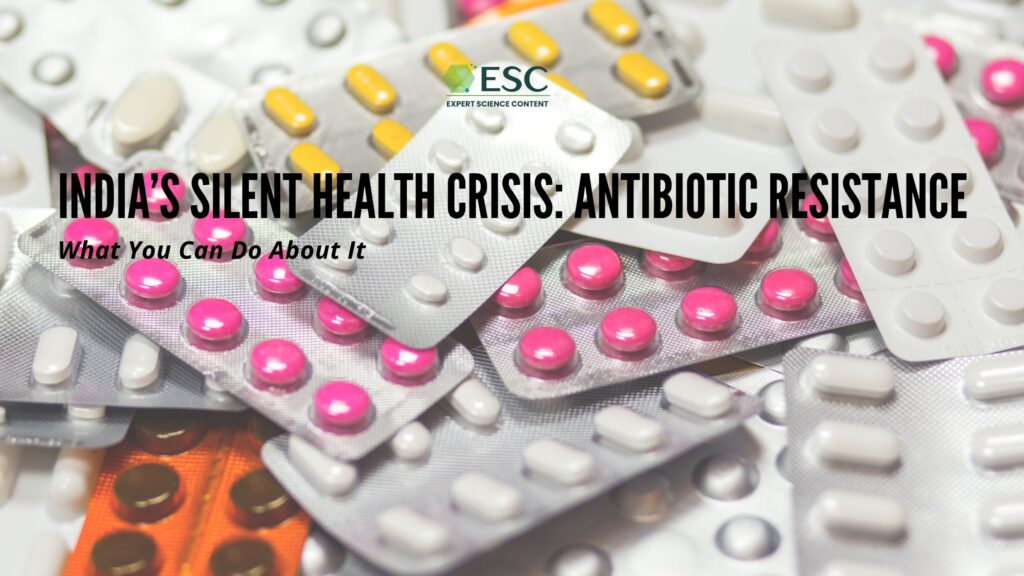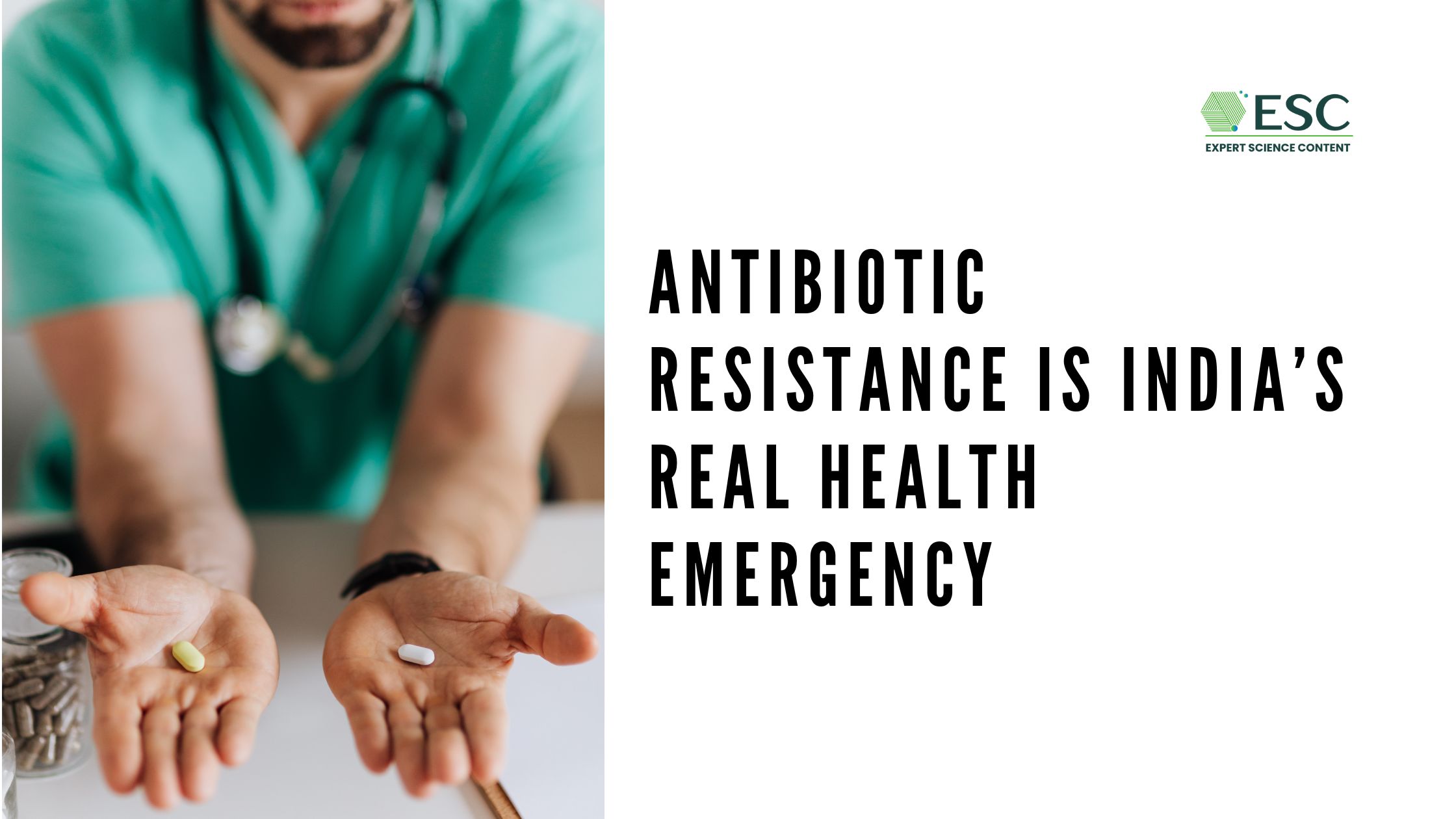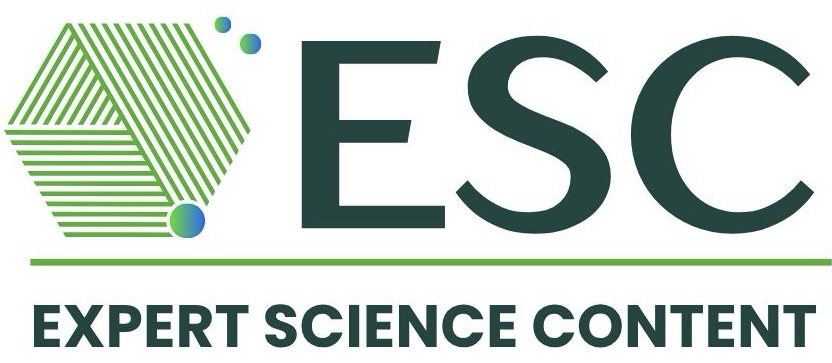India’s Silent Health Crisis: Antibiotic Resistance and What You Can Do About It
- Published By: Dr. Anindita Talukdar
- Published On: November 6, 2025
- 7 Minutes to read

The Silent Pandemic: Antibiotic Resistance
Antibiotics are one of the most significant inventions of the 20th century, saving millions of lives from infectious diseases. Antibiotics are called the “magic bullets” to combat bacteria and are recognized as the greatest medical intervention. Antibiotics have certainly benefitted humankind; however, antibiotic misuse and overuse encompasses a wide range of uses, including animal farm husbandry, and the prevention of disease in underdeveloped and developing countries and have for decades. Antibiotic resistance is the result of an evolutionary response of bacteria to the challenge of treatment with antibiotics. All these increasing use and abuse of antibiotics has resulted in microorganisms developing antimicrobial resistance (AMR). The antimicrobial resistance phenomenon is the ability of microorganisms including bacteria, viruses, fungi, and parasites to survive and grow in the presence of drugs designed to kill them. Without immediate global intervention, we risk entering a “post-antibiotic era” where common infections and minor injuries once again become deadly.
Continue to read this blog about the interesting topic of how helpful antibiotics become deadly in 2025. In this blog I am going to explain about how we are contributing to this crisis, and how one can protect oneself and what is the current scenario about uti antibiotics, natural antibiotics, metronidazole, amoxicillin, antibiotics for tooth infection etc.
Not in Future: It's Happening Now
Authorities in the United States and international experts (World Health Organization, 2014) consider antibiotic resistance to be one of the highest priorities in public health today. The increasing use of antibiotics, especially in developing countries, has provided bacteria with possible opportunities for antimicrobial resistance (AMR) to develop, which ultimately leads to much greater morbidity and mortality. During the 21st century, the incidence and prevalence of antimicrobial-resistant-bacterial infections that pose a silent pandemic threat to global public health has reached unprecedented levels, and urgent action is necessary as per current researched data. A recent comprehensive study, published in January 2022, suggested there were 1.27 million deaths attributable to infections caused by antimicrobial-resistant organisms in 2019, that’s nearly 5 million deaths that were linked in some form to drug resistant infections. This number is expected to increase to an estimated 10,000,000 annually by 2050 and is expected to be higher than deaths attributed to cancer per year.
Antibiotic Resistance Is India’s Real Health Emergency
 In spite of the importance of antibiotics in treating bacterial infections, their inappropriate use and overuse at doses and durations over decades have led to selection pressure and the emergence of resistant bacteria. In addition to human medicine, the emergence and spread of AMR from unscientific use of antimicrobials in livestock feed in many developing countries has also contributed significantly. It demands intensified surveillance and proper scientific selection on the excessive and unregulated use of antibiotics in animal feeds, to reduce the incidence of drug-resistant bacteria. Which is a very important step to prevent this health crisis.
In spite of the importance of antibiotics in treating bacterial infections, their inappropriate use and overuse at doses and durations over decades have led to selection pressure and the emergence of resistant bacteria. In addition to human medicine, the emergence and spread of AMR from unscientific use of antimicrobials in livestock feed in many developing countries has also contributed significantly. It demands intensified surveillance and proper scientific selection on the excessive and unregulated use of antibiotics in animal feeds, to reduce the incidence of drug-resistant bacteria. Which is a very important step to prevent this health crisis.
From a clinical perspective, all of the bacteria that are targeted will be susceptible to an antibiotic when it is first introduced, but through continued use, a bacterial population will develop resistance to the antibiotic.
From an evolutionary perspective, bacteria have mechanisms to adapt to the action of antibiotics through either (1) chromosomal gene mutations or (2) acquisition of foreign DNA through horizontal gene transfer (HGT) that encodes resistance determinants.
How We Are Contributing to the Crisis of Antibiotic Resistance
The World Health Organization (WHO) has warned that there will be 10 million deaths from drug resistance annually by the year 2050 if current practices continue. Additionally, a number of common-day to day actions significantly contribute to this growing crisis, including:
- Access to Antibiotics Without Prescription
In many countries, antibiotics are easily accessible over-the-counter without proper medical supervision. This promotes self-medication, often resulting in the wrong medication, at the wrong dosage, of the wrong duration. Research suggests in low- and middle-income countries, 60% of antibiotics dispensed are purchased without prescriptions, allowing bacteria to develop resistance as a result of improper use.
- Using Antibiotics for Incorrect Conditions
Individuals often take antibiotics for viral illnesses, like colds, flu, or COVID-19, for which antibiotics have no effect. The unintended exposure reinforces the selective pressure on bacteria, allowing resistant strains to survive and thrive. A multi-national study published in The Lancet, showed over 30% of antibiotic prescriptions written worldwide are not needed by patients.
- Incomplete Course of Treatment
When you stop taking antibiotics early (when your symptoms start going away), you may not have killed all the bacteria associated with your infection. This means that the remaining, more resistant bacteria can survive and possibly even develop resistance mechanisms for future treatments. For instance, by not completely killing the bacteria in a partial absence of treatment, the bacteria are afforded the opportunity to mutate the target sites of the antibiotic or have developed efflux pumps that will enable them to be resistant to the antibiotic in subsequent infections.
- Eating Antibiotics Fed Animals
There are antibiotics in the agricultural industry that promote growth and prevent disease in animals (use for human consumption), even if they are not sick. These antibiotics can make their way into the food chain and environment to expose humans to infected bacteria. According to the CDC, closer to 70% of medically important antibiotics sold each year in the United States are for animals rather than humans and constructed a major reservoir of resistance genes for future infections in humans.
How We Are Contributing to the Crisis of Antibiotic Resistance
The World Health Organization (WHO) has warned that there will be 10 million deaths from drug resistance annually by the year 2050 if current practices continue. Additionally, a number of common-day to day actions significantly contribute to this growing crisis, including:
- Access to Antibiotics Without Prescription
In many countries, antibiotics are easily accessible over-the-counter without proper medical supervision. This promotes self-medication, often resulting in the wrong medication, at the wrong dosage, of the wrong duration. Research suggests in low- and middle-income countries, 60% of antibiotics dispensed are purchased without prescriptions, allowing bacteria to develop resistance as a result of improper use.
- Using Antibiotics for Incorrect Conditions
Individuals often take antibiotics for viral illnesses, like colds, flu, or COVID-19, for which antibiotics have no effect. The unintended exposure reinforces the selective pressure on bacteria, allowing resistant strains to survive and thrive. A multi-national study published in The Lancet, showed over 30% of antibiotic prescriptions written worldwide are not needed by patients.
- Incomplete Course of Treatment
When you stop taking antibiotics early (when your symptoms start going away), you may not have killed all the bacteria associated with your infection. This means that the remaining, more resistant bacteria can survive and possibly even develop resistance mechanisms for future treatments. For instance, by not completely killing the bacteria in a partial absence of treatment, the bacteria are afforded the opportunity to mutate the target sites of the antibiotic or have developed efflux pumps that will enable them to be resistant to the antibiotic in subsequent infections.
- Eating Antibiotics Fed Animals
There are antibiotics in the agricultural industry that promote growth and prevent disease in animals (use for human consumption), even if they are not sick. These antibiotics can make their way into the food chain and environment to expose humans to infected bacteria. According to the CDC, closer to 70% of medically important antibiotics sold each year in the United States are for animals rather than humans and constructed a major reservoir of resistance genes for future infections in humans.
Present Situations: The Grim Truth About Antibiotic Resistance
The world is not in danger of an antibiotic resistance crisis – we are experiencing it; antibiotic-resistant bacteria or “superbugs” are making previous infections that are easily treated with antibiotics much more serious, potentially untreatable, and are now becoming a common occurrence. The World Health Organization (WHO) views antimicrobial resistance (AMR) as one of the top 10 global public health threats, with estimates of over 1.27 million drug-resistant infections resulting in death per year (and more individuals suffering from prolonged illnesses). Due to AMR, even infections that are normally characterized as trivial, such as urinary tract infections (treated by uti antibiotics i.e metronidazole, amoxicillin) and skin wounds, are taking longer to heal or result in greater symptoms and require multiple exposures to stronger antibiotics in order to resolve. As mentioned earlier in this blog, WHO predicts that, if no absolute turnaround occurs soon, by the year 2050, AMR could lead to the deaths of as many as 10 million people every year, even surpassing cancer as the leading cause of death in the world. All of this leaves modern medicine – including surgical procedures for simple elective procedures, chemotherapy, childbirth, and any number of new procedures – increasingly more complicated and full of risk due to the greater likelihood an individual will develop an untreatable infection.
Let’s not forget very common infections that female or even male faces, which is UTI infection and UTI antibiotics resistance. A 2019 study found that more than 92 percent of bacteria that cause UTIs are resistant to at least one common UTI antibiotics, and almost 80 percent are resistant to (UTI antibiotics) at least two. Escherichia coli is the most common cause of UTIs. Few over use UTI antibiotics are metronidazole, and amoxicillin. Which are serious concerns over the years. Let’s look into few points about current scenario:
- Treating minor infections now takes weeks instead of days, as effective antibiotics are no longer able to produce effective results.
- More than 1.27 million deaths per year around the globe are attributed to infections due to AMR (The Lancet, 2022).
- WHO warns that, by the year 2050, AMR will cause more deaths than cancer and will result in untold health and economic impacts.
- This means that routine surgical procedures, organ transplantation, and childbirth are all becoming much more dangerous due to the risk of untreatable bacterial infections.
- Common bacteria such as E. coli, Klebsiella pneumoniae, Staphylococcus aureus, are showing alarming rates of resistance against last-resort antibiotics, such as carbapenems, colistin, metronidazole, and amoxicillin.
- According to a UK Review on Antimicrobial Resistance, the costs associated with AMR is expected to rise significantly to $100 trillion by 2050.
Tips to Protect Yourself and Prevent Antibiotic Resistance

- Take antibiotics only when prescribed by a certified dDoctor: Never self-medicate or buy antibiotics without a prescription. Each infection requires specific treatment, using the wrong antibiotic or taking it unnecessarily only fuels resistance.
- Always complete the full course: Even if you start feeling better, finish the entire prescribed course. Stopping early allows surviving bacteria to adapt and develop resistance, making future infections harder to treat.
- Choose antibiotic-free meat and dairy products: Opt for meat, milk, and eggs labeled antibiotic-free or raised without antibiotics. Reducing demand for antibiotic-fed livestock helps curb the agricultural overuse that contributes to resistant bacteria entering the food chain.
- Maintain good hygiene and strengthen immunity naturally: Wash hands regularly with soap and water, especially before eating or after contact with public surfaces. Support your immune system through a balanced diet rich in vitamin C, zinc, probiotics, natural antibiotics and antioxidants from fruits, vegetables, and fermented foods.
- Avoid taking antibiotics for viral infections: Antibiotics do not work against viruses such as colds, flu, or COVID-19. Using them in these cases only harms beneficial bacteria and increases the risk of resistance.
- For children: Encourage healthy exposure, over-cleanliness does not help our child in the long run. Let children play outdoors and interact with natural environments. Over sanitization can weaken their immune system by preventing it from learning to distinguish between harmless particles, allergens, and harmful pathogens. Controlled exposure helps build stronger, more adaptive immunity.
- Natural antibiotics: Natural antibiotics are substances obtained from the plants, fungi, and minerals that damage or kill microorganisms. Natural antibiotics such as turmeric have antibacterial properties and are utilized in traditional medicine for curing ailments. Few examples of natural antibiotics: Garlic, honey, turmeric, ginger, neem, clove, myrrh, and thyme etc. Natural antibiotics may not be effective for severe infections but as a researcher with 10+ years of experience with medicinal plants, I must say that these natural ingredients never harm you if consumed in moderation. So it does not hurt us to try natural antibiotics rather than relying on medicine for small infections or headaches! Also, be sure to discuss your interest in natural antibiotics with your doctor, so that they can help you weigh the potential benefits and risks of each extract or regimen.
Key Takeaway
I appreciate you reaching the end of reading this article. Well done, you managed to stick it out through this informative health crisis. Lets not fear about this, antibiotic resistance may seem like an unstoppable global challenge, but every mindful action we take helps protect our future. By using antibiotics responsibly, supporting our immune systems through healthy habits, and choosing cleaner, antibiotic-free food, we become part of the solution. Remember, prevention starts with awareness, and small, consistent steps lead to powerful change. Together, we can preserve the effectiveness of antibiotics for generations to come.
Antibiotic resistance can’t be stopped overnight, but every responsible choice adds up. And moreover remember awareness plays a very important step here, so let’s spread awareness about the uses of antibiotics and using antibiotics wisely, maintaining hygiene, and supporting immunity naturally. Share this blog as much as you can to help the rest of the world to fight against antibiotic resistance.
Curious to learn more about science and innovation? Unlock deeper insights! Visit my blog and start thinking differently. Need scientifically backed content to promote health, healthy habits, or positive thinking? Connect with us today!

Dr. Anindita Talukdar
The creative behind ESC sharing smart actionable tips and insights to level up writing and research skill.
Join ESC
Get our newsletter

Dr. Anindita Talukdar
The creative behind ESC sharing smart actionable tips and insights to level up writing and research skill.

Very informative blog, I must say. Thanks for sharing this blog at the perfect time.